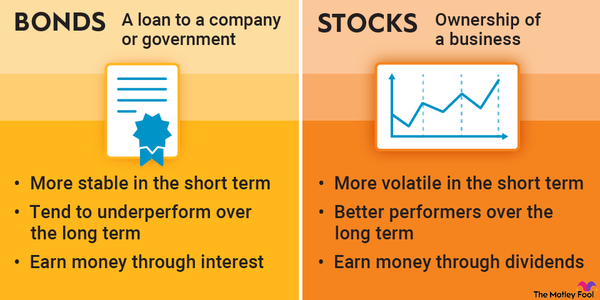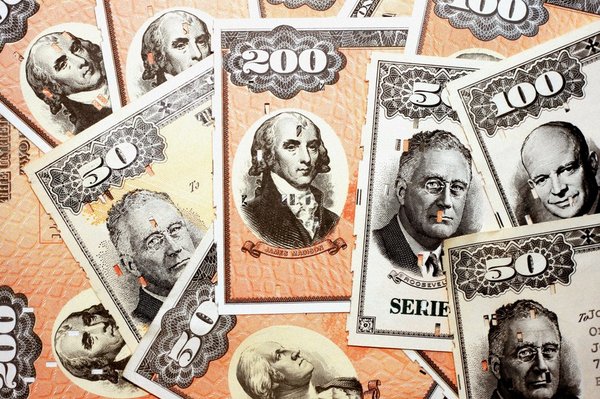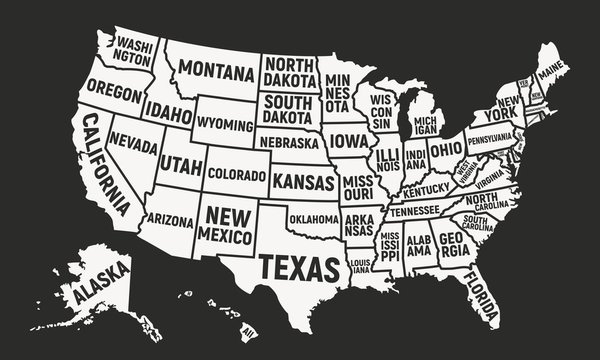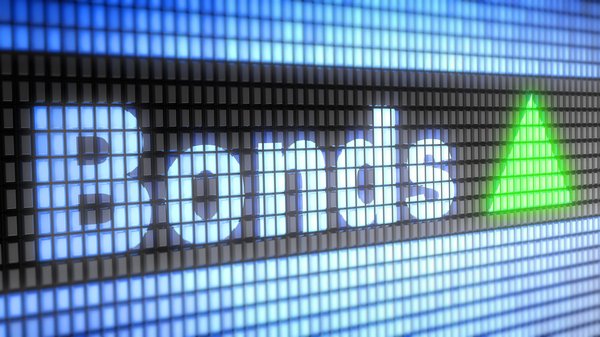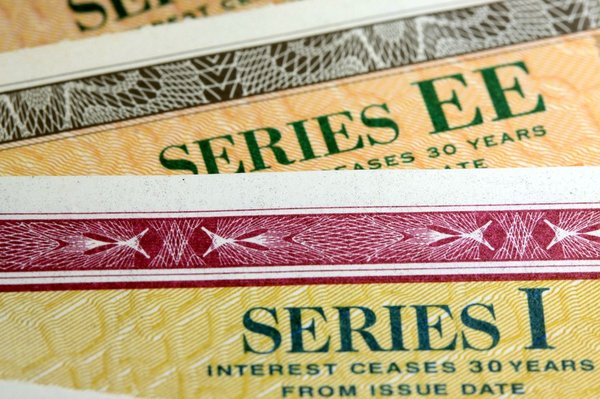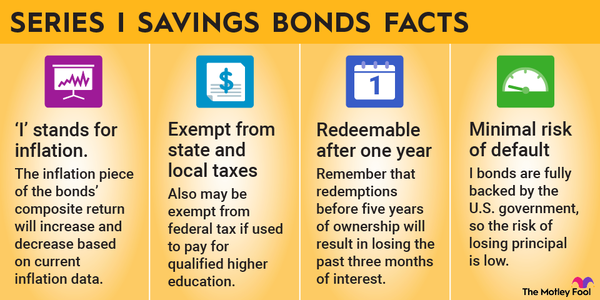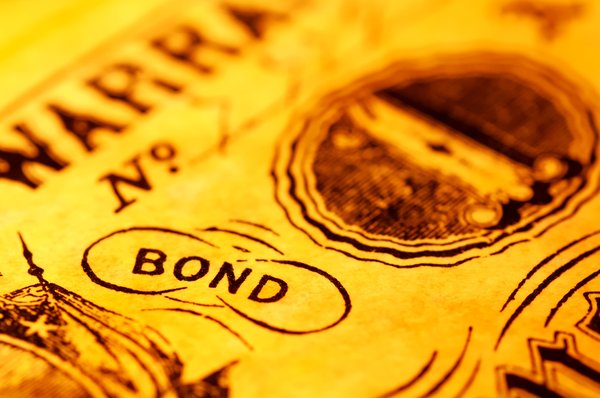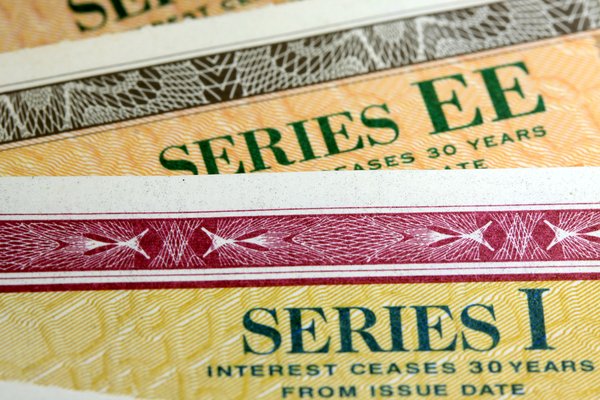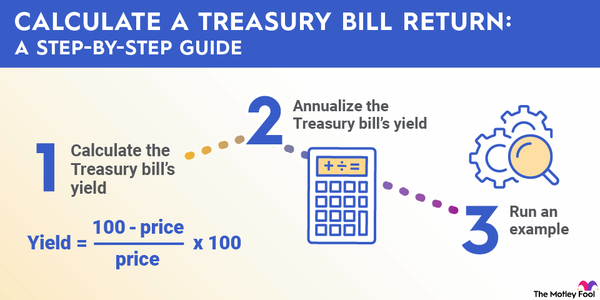Bonds are getting a lot of attention from investors these days, and it’s easy to see why. With inflation still elevated and interest rates at their highest levels since the financial crisis, bond yields are as high as they've been in years. The yield on the 10-Year Treasury note was hovering above 4% in late 2023, and almost hit 5% for the first time since 2007. In such an environment, it's not surprising that investors have a newfound excitement for bonds.
Bonds
In addition to that guaranteed fixed income return, bonds offer some other advantages in a high-interest-rate environment. For example, if interest rates fall, the price of a bond goes up, and you could make money selling your bond rather than holding it until maturity.
If interest rates continue to rise, more investors are likely to turn to bonds to earn a reliable return on their investment. That includes bond funds and bond exchange-traded funds (ETFs), as well as options such as corporate bonds and municipal bonds. If you want to invest in bonds, keep reading to see some of the best bond and bond funds you can buy today.
Interest Rate
Top bonds
Top 8 Bonds to Invest In for the Long Term
| Name | Ticker | Yield | Description |
|---|---|---|---|
| 10-Year Treasury Note | (ICE:^TNX) | 4.2% | Benchmark Treasury bond. |
| I Savings Bonds | N/A | 5.3% | 30-year savings bond issued by the U.S. Treasury that adjusts for inflation. |
| iShares TIPS Bond ETF | (NYSEMKT:TIP) | 5.7% | Fund holding Treasury inflation-protected securities. |
| Nuveen High-Yield Municipal Bond Fund | (NASDAQ:NHRMX) | 5.0% | Fund that invests in lower-quality municipal bonds. |
| Vanguard Short-Term Corporate Bond Index Fund | (NASDAQ:VSCSX) | 5.6% | Fund that tracks the Bloomberg 1-5 year corporate bond index. |
| Guggenheim Total Return Bond Fund | (NASDAQ:GIBIX) | 5.5% | Bond fund that seeks to maximize total return. |
| Vanguard Total International Bond Index Fund | (NASDAQ:BNDX) | 3.4% | Fund that tracks the performance of a Bloomberg index, excluding U.S. assets. |
| Fidelity Short-Term Bond Fund | (NASDAQ:FSHBX) | 5.1% | Fund managed to have similar interest rate risk to the Bloomberg Barclays U.S. 1-3 Year Government/Credit Bond Index. |
1. 10-year Treasury Note
1. 10-year Treasury Note
If you're looking for a straightforward bond investment, it's hard to beat Treasuries. U.S. Treasury bonds are considered the safest in the world and are generally called "risk-free." The 10-year rate is considered a benchmark and is used to determine other interest rates, such as mortgage rates, auto loans, student loans, and credit cards.
Treasury yields are closely tied to the federal funds rate, so they should continue to move higher if the Federal Reserve keeps raising rates.
Currently, short-term yields like the two-year yield are even higher than the 10-year, meaning the yield curve has inverted. That shows that investors expect interest rates to come down within a few years.
2. I Savings Bonds
2. I Savings Bonds
If you're looking for another straightforward option, I Bonds -- also known as I Savings Bonds -- are a great way to earn interest and protect yourself from inflation. Through the end of April 2024, I Bonds were offering an interest rate of 5.27% (1.3% fixed and 3.97% variable). People who buy I Bonds by the end of April 2024 will lock in the 1.3% fixed rate for the life of the bond (30 years), while the variable rate will reset every six months depending on inflation.
I Bonds also pay monthly rather than semiannually, and they can't be traded. You have to wait a year to cash them in, and their maturities can last as long as 30 years.
Because they adjust for inflation, yields could fall if the inflation rate goes down.
3. iShares TIPS Bond ETF
3. iShares TIPS Bond ETF
Like I Bonds, TIPS also offer investors protection from inflation (TIPS stands for Treasury Inflation-Protected Securities). You can buy TIPS directly from the government through treasurydirect.gov. You can also invest in them through ETFs such as the iShares TIPS Bond ETF.
The fund invests in a range of TIPS securities that have at least one year left until maturity, are investment-grade, and have more than $300 million in outstanding face value.
The TIPS ETF paid an impressive yield of 5.7% in late 2023. Like I Bonds, however, yields on TIPS can fall when the inflation rate declines.
I bonds are a great way to earn interest and protect yourself from inflation.
4. Nuveen High-Yield Municipal Bond Fund
4. Nuveen High-Yield Municipal Bond Fund
Investors in bonds generally have two choices. They can invest in investment-grade bonds, which are considered safer but offer lower yields, or they can buy high-yield bonds, which are riskier but pay more.
Municipal bond funds offer one way to get exposure to high-yield bonds and come with the added bonus that the interest is free of federal income taxes and free of state taxes if you buy municipal bonds from your state of residence.
One of the best municipal bond funds is the Nuveen High-Yield Municipal Bond Fund. It offered a 5.0% yield in late 2023, and the fund aims to earn a high current income that's exempt from federal taxes. It holds mostly lower-quality, long-term municipal bonds.
5. Vanguard Short-Term Corporate Bond Index Fund
5. Vanguard Short-Term Corporate Bond Index Fund
Short-term bonds offer some advantages over long-term bonds, depending on your investing needs. Because of the shorter duration of short-term bonds -- considered to have maturities of five years or less -- they have less interest-rate risk and are more likely to preserve the principal.
Short-term bonds are especially attractive these days because the yield curve has inverted, meaning short-term bond yields are higher than long-term bond yields. One way to take advantage of this is with the Vanguard Short-Term Corporate Bond Index Fund, one of the best corporate bond funds.
The fund holds a range of bonds from blue chip companies such as Boeing (BA 1.51%) and Bank of America (BAC -1.07%). It aims to track the Bloomberg U.S. Corporate 1-5 Year index. The fund offered a yield of 5.6% in late 2023.
6. Guggenheim Total Return Bond Fund
6. Guggenheim Total Return Bond Fund
A total return bond fund differs from the typical bond fund by generating returns both through coupon payments and increasing the price of the bond. This can happen either because yields fall, which is generally determined by central banks and macroeconomic forces, or because the fund owns bonds whose credit ratings improve, which also leads to falling yields and rising prices.
The Guggenheim Total Return Bond Fund owns a range of bonds, including Treasuries, municipal bonds, and corporate bonds. It paid a yield of 5.5% as of late 2023.
7. Vanguard Total International Bond Index Fund
7. Vanguard Total International Bond Index Fund
If you're looking for diversification from your bonds, there's no reason to stay within U.S. borders. Emerging markets can offer some of the best opportunities for high-yield investors, so it's worth considering international bonds like the Vanguard Total International Bond Index Fund.
The fund's top holdings are European government bonds, although it holds more than 100 different bonds, largely investment-grade. It tracks a Bloomberg index adjusted to exclude U.S. bonds, and it offered a yield of 3.4% in late 2023.
8. Fidelity Short-Term Bond Fund
8. Fidelity Short-Term Bond Fund
If you're interested in short-term bonds, you don't have to limit yourself to corporate bonds. The Fidelity Short-Term Bond Fund, one of the best short-term bond funds available, invests in both short-term Treasury bills and corporate bonds from companies such as financial giants Morgan Stanley (MS -1.38%), Bank of America, Citi (C -1.09%), and American Express (AXP -0.84%).
The fund is managed to have a similar overall interest rate risk to the Bloomberg Barclays U.S. 1-3 Year Government/Credit Bond index and aims for a dollar-weighted average of three years or less. It offered a yield of 4.3% in late 2023.
Related investing topics
Which bond is right for you?
Whether you choose high-yield, investment-grade, foreign or domestic, there are a wide range of bonds and bond funds available on the market that can suit the needs of almost any investor looking for fixed income.
In an environment of rising interest rates, bonds are only going to become more attractive. Take the time to learn which type is best for you.
FAQs on investing in bonds
What bonds are best to invest in?
The best bonds to invest in depend on your risk tolerance and desired income level. For example, if you're seeking to protect your money from inflation, I-Bonds or TIPS are the best bonds to buy. On the other hand, if you're seeking to earn a solid fixed-income payment with minimal risk, then investment-grade corporate bonds would be the best option.
Which bond gives the highest return?
Bonds with non-investment grade ratings (junk bonds) typically offer the highest return potential. They tend to offer a higher fixed-income yield than investment-grade, municipal, and government bonds. In addition, they offer some appreciation potential if the underlying company receives a credit rating upgrade, making the bonds less risky.
Which bonds pay the highest yield?
Bonds with a non-investment grade rating (junk bonds) typically pay the highest yields. These bonds are at a higher risk of default (non-payment), so they offer a higher yield to compensate investors for their higher risk profile.
What bonds make you the most money?
Non-investment grade rated bonds (junk bonds) have the potential of making the most money from their higher yields. However, they have a higher risk of default. In addition, convertible bonds (i.e., bonds the can convert into stock) can also be big money-makers if the underlying stock delivers significant price appreciation.










